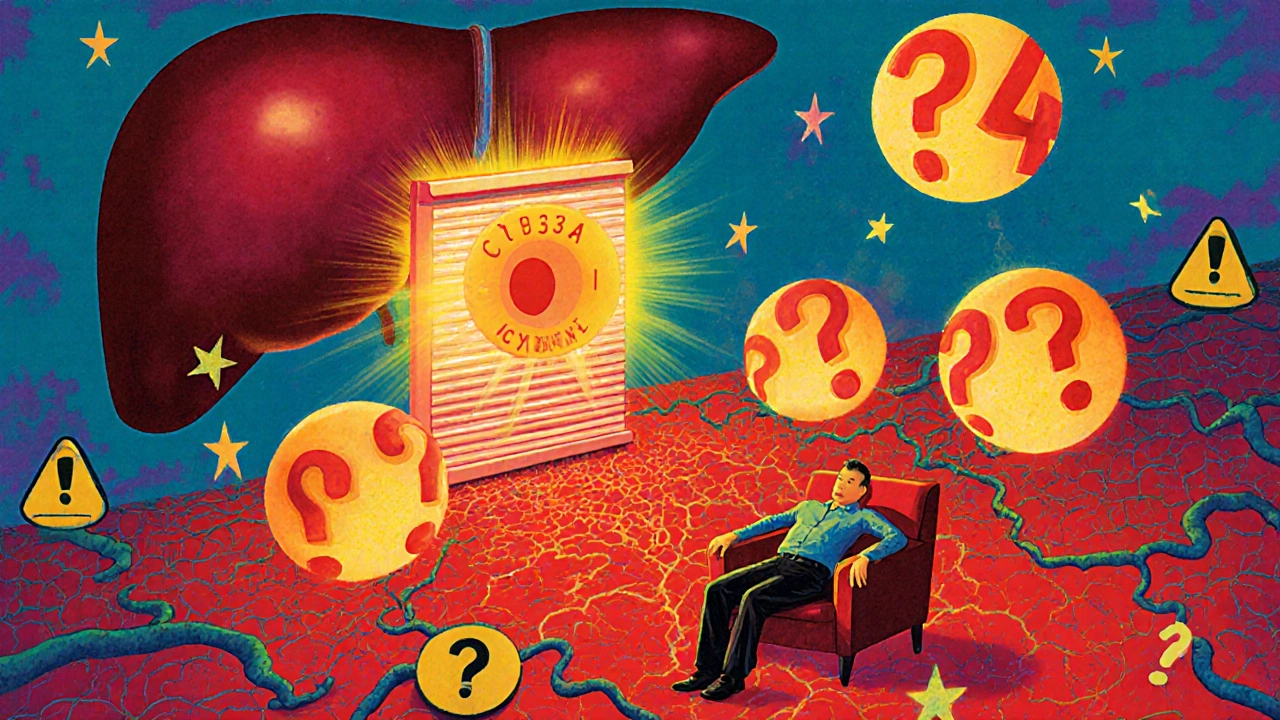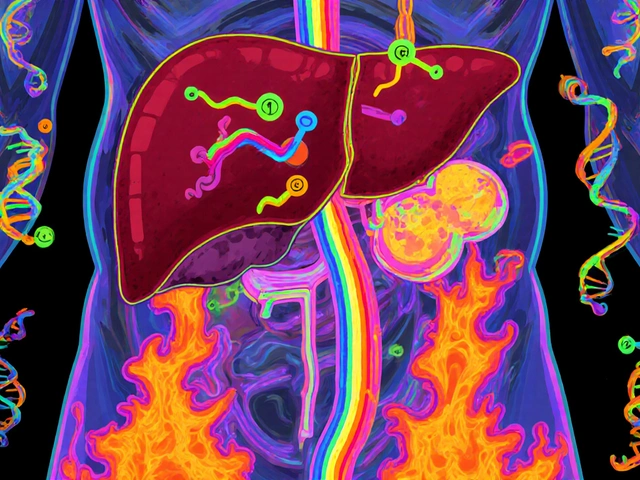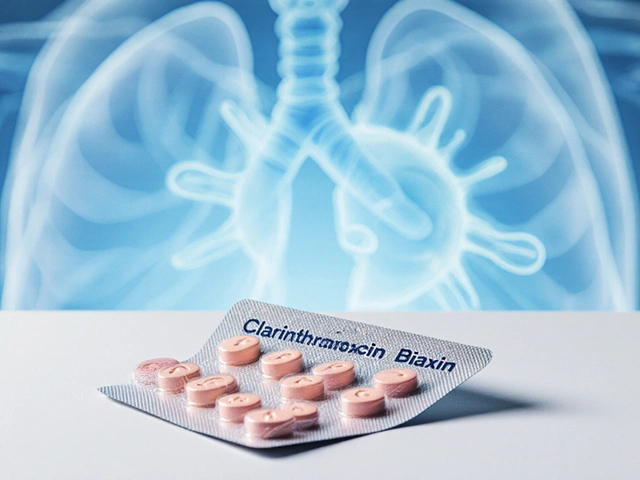Clarithromycin-CCB Interaction Checker
Assess Your Risk
This tool evaluates the risk of dangerous hypotension (low blood pressure) when taking clarithromycin with calcium channel blockers. Select your medication details below to see your personalized risk assessment.
Imagine taking clarithromycin for a sinus infection while also managing high blood pressure with nifedipine or amlodipine. Sounds routine, right? But what if that simple combo could drop your blood pressure so fast you end up in the ER? This isn’t hypothetical. Every year in the U.S., thousands of older adults experience dangerous drops in blood pressure - not from a stroke or heart attack, but from two commonly prescribed drugs working together in a way no one warned them about.
Why This Interaction Is So Dangerous
Clarithromycin doesn’t just kill bacteria. It also shuts down a key liver enzyme called CYP3A4, which is responsible for breaking down many medications, including most calcium channel blockers (CCBs). When this enzyme is blocked, CCBs build up in your bloodstream. Too much nifedipine, amlodipine, or felodipine means your blood vessels relax too much. Your heart can’t pump hard enough to keep pressure up. That’s how you go from 130/80 to 80/50 in under 48 hours.This isn’t a rare side effect. A landmark 2013 study of nearly 200,000 patients found that those taking clarithromycin with a CCB had more than double the risk of hospitalization for dangerously low blood pressure and acute kidney injury compared to those taking azithromycin instead. The risk was highest with nifedipine - one in every 160 people on that combo ended up hospitalized. For amlodipine, it was less common but still serious enough to warrant alarm.
Which Calcium Channel Blockers Are Riskiest?
Not all CCBs are created equal when it comes to this interaction. The dihydropyridine class - including nifedipine, amlodipine, felodipine, and nicardipine - are the main culprits because they rely almost entirely on CYP3A4 for clearance. Among them, nifedipine carries the highest risk. Studies show clarithromycin can spike nifedipine levels by nearly 3 times. Amlodipine, while still risky, is affected less - about a 60% increase in blood levels. But since it’s the most commonly prescribed CCB, it ends up being involved in the most cases overall.Verapamil and diltiazem are non-dihydropyridine CCBs. They also interact with clarithromycin, but their mechanism is slightly different. They slow heart rate in addition to lowering blood pressure. When combined with clarithromycin, you can get both low BP and a dangerously slow pulse - a double threat, especially in older adults or those with heart disease.
The Real-World Consequences
Case reports tell the real story. One 76-year-old man on nifedipine 30 mg daily started clarithromycin for pneumonia. Within two days, his systolic blood pressure crashed from 130 to 70. He needed IV fluids and ICU monitoring. Another 72-year-old woman on amlodipine 10 mg daily developed a heart rate of 48 beats per minute and collapsed after starting clarithromycin. She had no history of bradycardia - until the antibiotic hit.The FDA added a black box warning to clarithromycin in 2011 - the strongest possible alert - specifically naming calcium channel blockers as a high-risk combination. Yet, a 2016 study found that over 12% of clarithromycin prescriptions in patients over 65 were still given to people taking CYP3A4 substrates like CCBs. Why? Because many prescribers don’t check interactions in real time. EHR systems often don’t flag it. And many patients don’t know to mention their blood pressure meds when they’re prescribed an antibiotic.

Why Azithromycin Is the Safe Alternative
Here’s the good news: there’s a clear, safe replacement. Azithromycin. Unlike clarithromycin, it doesn’t inhibit CYP3A4. The same 2013 JAMA study showed azithromycin had no increased risk of hypotension or kidney injury when taken with CCBs. It’s just as effective for common infections like bronchitis, sinusitis, and strep throat.Doctors who’ve seen the consequences now make azithromycin their default macrolide for patients on CCBs. In 2022, 68% of macrolide prescriptions for patients on calcium channel blockers were azithromycin - up from just over half in 2013. That shift happened because clinicians learned the hard way. One ER physician in Chicago told me, “I used to think clarithromycin was fine. Then I saw three patients in six months with BP crashes. Now I never prescribe it if they’re on amlodipine or nifedipine. Azithromycin is just as good and doesn’t kill people.”
Who’s at Highest Risk?
Age matters. People over 65 are more vulnerable because their livers and kidneys don’t clear drugs as efficiently. Those with chronic kidney disease (eGFR below 60) are at even greater risk - reduced clearance means even more drug buildup. Patients with heart failure or existing low blood pressure are also more likely to crash. And if you’re already on a beta-blocker like metoprolol or atenolol, the risk multiplies. Beta-blockers slow the heart, CCBs relax vessels, and clarithromycin pushes both effects into overdrive.Even healthy-looking older adults can be caught off guard. A 70-year-old with no other medical problems took clarithromycin for a cold and a daily dose of amlodipine. Within 36 hours, he felt dizzy, collapsed, and broke his hip. His BP had dropped to 85/55. He didn’t have a history of fainting. He didn’t have a heart condition. He just took two common drugs together.

What You Should Do - Right Now
If you’re taking a calcium channel blocker - whether it’s nifedipine, amlodipine, diltiazem, or verapamil - and your doctor prescribes clarithromycin, ask this question: “Can I take azithromycin instead?” Don’t wait. Don’t assume it’s safe because “it’s just an antibiotic.”Here’s what to do if you’re already on both:
- Check your blood pressure daily - ideally twice a day - for the first 72 hours after starting clarithromycin.
- If your systolic pressure drops below 90 mm Hg, or falls more than 30 mm Hg from your normal baseline, stop clarithromycin and call your doctor immediately.
- Watch for dizziness, fainting, extreme fatigue, or confusion. These are signs your brain isn’t getting enough blood.
- Never stop your blood pressure medication without talking to your doctor. But do stop clarithromycin if you feel unsafe.
Pharmacists are your allies. Ask them to review all your medications when you pick up a new antibiotic. Many now run automated interaction checks - but not all. If they don’t flag it, speak up.
The Bigger Picture
This isn’t just about two drugs. It’s about how we prescribe. We treat antibiotics like harmless, routine prescriptions. But they’re powerful biological tools. A single dose of clarithromycin can alter your body’s chemistry for days. And when it’s mixed with drugs that control vital functions like blood pressure, the consequences can be fatal.Regulatory agencies know this. The American Geriatrics Society’s Beers Criteria lists clarithromycin as potentially inappropriate in older adults taking CYP3A4 substrates. The STOPP/START guidelines now explicitly recommend avoiding clarithromycin in patients on dihydropyridine CCBs. Yet, in 2022, over 8,400 Americans were hospitalized and 320 died from this interaction. That’s not bad luck. That’s preventable harm.
The solution isn’t more warnings on labels. It’s better systems. Better training. Better conversations. And most of all - it’s patients asking questions. If you’re on a blood pressure pill and your doctor gives you clarithromycin, don’t just say “thank you.” Say, “Is there a safer option?”
Can clarithromycin and amlodipine be taken together safely?
No, it’s not safe. While amlodipine carries a lower risk than nifedipine, clarithromycin still increases amlodipine levels by about 60%, which can cause dangerous drops in blood pressure. The risk is especially high in older adults or those with kidney problems. Azithromycin is the recommended alternative.
How quickly does the interaction happen?
Symptoms can appear within 24 to 72 hours after starting clarithromycin. Blood pressure drops are often sudden and severe. Many patients report dizziness, lightheadedness, or fainting within two days. Don’t wait for symptoms to get worse - monitor your blood pressure daily during this time.
Is azithromycin really as effective as clarithromycin?
Yes. For most common infections - like sinusitis, bronchitis, strep throat, and some pneumonia cases - azithromycin works just as well as clarithromycin. It’s not stronger or weaker; it just doesn’t interfere with CYP3A4. That’s why guidelines now recommend it as the first-choice macrolide when a patient is on a calcium channel blocker.
What if I’m on verapamil or diltiazem instead of amlodipine?
You’re still at risk. Verapamil and diltiazem are metabolized by CYP3A4 too, and they also slow heart rate. Combining them with clarithromycin can lead to both low blood pressure and a dangerously slow heartbeat. This combo is especially dangerous for older adults or those with heart conditions. Azithromycin remains the safest choice.
Can I take clarithromycin if I stop my calcium channel blocker for a few days?
No. Stopping your blood pressure medication without medical supervision can be dangerous. It can cause rebound hypertension, heart attack, or stroke. Never adjust your CCB dose on your own. The solution isn’t to stop one drug - it’s to switch to a safer antibiotic like azithromycin.
Are there any other antibiotics I should avoid with calcium channel blockers?
Yes. Erythromycin is another macrolide that strongly inhibits CYP3A4 and carries the same risks as clarithromycin. Fluoroquinolones like ciprofloxacin and levofloxacin can also interact with some CCBs, though less predictably. Always check with your pharmacist or doctor before starting any new antibiotic if you’re on a calcium channel blocker.
How can I make sure my doctor knows I’m on a calcium channel blocker?
Keep a written list of all your medications - including doses - and bring it to every appointment. Tell your doctor, “I’m on a blood pressure pill called [name], and I’m concerned about interactions.” If you use a pharmacy app, make sure your profile is updated. Many hospitals now have medication reconciliation systems, but they’re only as good as the information you give them.
What to Do Next
If you’re currently taking clarithromycin and a calcium channel blocker, don’t panic - but act. Call your doctor or pharmacist today. Ask if you can switch to azithromycin. If you’re not sure what you’re taking, check your prescription label. Nifedipine, amlodipine, felodipine, verapamil, and diltiazem are the common ones.If you’ve had unexplained dizziness, fainting, or low blood pressure after starting an antibiotic, mention it to your provider. This interaction is underdiagnosed because it’s often mistaken for something else - dehydration, a virus, or just “getting older.” But it’s not normal. It’s preventable.
Knowledge saves lives. And sometimes, all it takes is one question: “Is there a safer option?”









November 22, 2025 AT 03:06
Bryson Carroll
So let me get this right we’re telling old people to stop taking their blood pressure meds because some dumb antibiotic might make them dizzy
Meanwhile the real problem is doctors prescribing clarithromycin like it’s candy and no one checks interactions because EHRs are broken
Fix the system not the patient
November 23, 2025 AT 14:12
Lisa Lee
Why are we even talking about this like it’s news in Canada we’ve had warnings for years
US healthcare is a joke
November 24, 2025 AT 16:25
Jennifer Shannon
You know… I’ve been thinking about this for days now, and it’s not just about clarithromycin or amlodipine-it’s about how we’ve normalized the idea that medicine is just a checklist, right? We don’t talk to each other anymore, we just click ‘prescribe’ and assume someone else caught the interaction
And then we’re shocked when a 72-year-old woman collapses because her pharmacist didn’t flag it, her doctor didn’t ask, and she didn’t know to say anything
It’s not malice, it’s just… inertia
We treat elderly patients like they’re background noise in a clinical algorithm, and that’s the real tragedy here-not the drug interaction, but the silence around it
And azithromycin? It’s not just ‘safe,’ it’s elegant-it works just as well, with zero extra risk, and yet we still don’t default to it
Why? Because change requires effort, and effort is expensive, and we’ve built a system that rewards speed over safety
I wish we could teach medical students to pause before they write a script, to look at the whole person, not just the diagnosis
And I wish patients felt safe enough to ask, ‘Is there another way?’ without sounding like they’re questioning their doctor’s intelligence
It’s not about blame, it’s about design
And right now, the design is broken
November 26, 2025 AT 01:59
Suzan Wanjiru
Just had a patient on amlodipine get clarithromycin last week
BP dropped to 88/52
She was fine after stopping it but scared as hell
Always check med lists before prescribing anything
Pharmacist flagged it but the doc overruled
Don’t let that happen
November 27, 2025 AT 11:29
Kezia Katherine Lewis
Pharmacovigilance gaps in primary care remain systemic. The CYP3A4-mediated pharmacokinetic interaction between clarithromycin and dihydropyridine calcium channel blockers is well-documented in the literature, yet real-world adherence to contraindication protocols remains suboptimal due to cognitive load and fragmented EHR decision support
Furthermore, the Beers Criteria and STOPP/START guidelines are underutilized in ambulatory settings, contributing to preventable adverse drug events in the geriatric population
Standardizing macrolide selection protocols-azithromycin as first-line in CCB recipients-could reduce hospitalizations by >60% based on epidemiologic modeling
November 27, 2025 AT 15:19
Henrik Stacke
My goodness, this is terrifying-and yet so quietly common
I work in a small GP practice in London, and we had a patient just last month-78, on nifedipine, got clarithromycin for a chest infection, ended up in A&E with a BP of 76/48
He didn’t even know he was on a blood pressure pill-he thought it was for his ‘swollen ankles’
And the doctor? He didn’t check the meds because the patient said ‘I take a few pills’
It’s not negligence, it’s exhaustion
We’re all drowning in screens and checkboxes
But here’s the thing-when we switched to azithromycin as our default for anyone over 65 on any CCB, the number of hypotension referrals dropped by 70% in six months
It’s not magic
It’s just… thinking before you type
November 27, 2025 AT 17:23
Manjistha Roy
As someone who has seen elderly relatives suffer from drug interactions, I want to say thank you for writing this
Many people in my community don’t know how to ask questions about medications
We need more plain-language education in clinics, community centers, even pharmacies
Not just warnings on labels
Real conversations
And we need pharmacists to be more visible as safety advocates, not just dispensers
Knowledge is power, but only if it’s shared
November 29, 2025 AT 10:34
Jennifer Skolney
Just shared this with my mom who’s on amlodipine
She’s 71 and was about to take clarithromycin for a sinus infection
She called her doctor and switched to azithromycin
Thank you for this
❤️
November 29, 2025 AT 17:40
JD Mette
This is important
Wish more people knew
November 29, 2025 AT 22:52
Olanrewaju Jeph
While the pharmacological interaction is well established, the real issue lies in the absence of standardized medication reconciliation protocols across healthcare institutions
Physicians must be held accountable for cross-referencing concomitant medications prior to prescribing, and electronic health record systems must enforce mandatory interaction alerts with no option to bypass without documented justification
Furthermore, patient education materials should be translated into multiple languages and distributed at point-of-prescription, not merely archived in digital portals
Prevention is not optional-it is a professional obligation